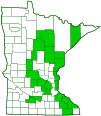narrow-leaved wild leek
(Allium burdickii)
Conservation • Description • Habitat • Ecology • Use • Distribution • Taxonomy
Conservation Status |
|
|||||||
| IUCN Red List | not listed |
|||||||
| NatureServe | NNR - Unranked SNR - Unranked |
|||||||
| Minnesota | not listed |
|||||||
Description |
||
Narrow-leaved wild leek is an erect, perennial, forb rising from 2 to 6 clustered bulbs. All parts of the plant, including the flower, have a strong onion odor. The bulbs are ¾″ to 1½″ tall and ⅛″ to ⅔″ wide. They are egg-shaped to cone-shaped. They are encased in a brownish or grayish membranous coating. Two to three basal leaves arise tightly rolled together at the soil surface. Later they spread, forming a basal rosette. They are 8″ to 12″ long, ¾″ to 1¼″ wide, solid, flat, and untoothed. They are either lance-shaped, tapering to a point at the tip and tapering gradually to the stalk at the base, to narrowly oval, widest at the middle and narrower at the two equal ends. They are nearly stalkless or on short green leaf stalks. The leaves die back before the flower is fully expanded and functioning. A single, leafless, hairless, round flowering stem (scape) rises 5″ to 6¼″ from the center of the rosette of leaves. It is curved or bent slightly toward the top, somewhat zigzagged. The inflorescence is a single umbrella-like flowering cluster (umbel) at the top of the scape. The cluster is 1¼″ in diameter, erect, and shaped like half of a sphere. It has 12 to 18 flowers and no bulblets. There are two large bracts (spathe), ⅜″ to ¾″ long, at the base of the cluster. The spathe surrounds and enclose the cluster and is split on one side. It does not fall off but remains even as the fruits develop. The flowers are ¼″ long and bell-shaped. They are composed of 6 white to cream tepals (3 petals and 3 sepals that are similar in appearance). The tepals are erect and have blunt tips. They remain on the plant even as the fruit develops. They are on ⅜″ to ¾″ long flower stalks, the inner ones on shorter stalks, the outer ones on longer stalks, like an umbrella. The fruits form a small ball-like cluster at the top of the stem. The fruit is a shiny 3-celled seed capsule, each cell containing 1 seed (the scientific name tricoccum is Latin for three-seeded). |
||
Height |
||
4″ to 12″ |
||
Flower Color |
||
White to cream |
||
Similar Species |
||
Wild leek (Allium tricoccum) has wider leaves,1″ to 3″ wide. They are on ¾″ to 2⅓″ long, distinct, slender, reddish leaf stalks. The bulbs are longer, ⅔″ to 2⅓″ tall. The scape is much longer, 10″ to 14″ tall. The spathe bracts are larger, ½″ to 1⅛″ long. The umbel has 30 to 50 individual flowers. Lily of the valley (Convallaria majalis) has similar leaves but they are shorter, 6″ to 9″, and much wider, 1″ to 5″ wide. The inflorescence is a loose, elongated clusted of nodding flowers. |
||
Habitat |
||
Moist. Rich woods. Dappled sunlight. |
||
Ecology |
||
Flowering |
||
May to July |
||
Pests and Diseases |
||
|
||
Use |
||
|
||
Distribution |
||||
|
Sources |
|||
| 5/18/2023 | ||||
Nativity |
||||
Native |
||||
Occurrence |
||||
|
||||
Taxonomy |
|||
| Kingdom | Plantae (Plants) | ||
| Division | Tracheophyta (Vascular Plants) | ||
| Subdivision | Spermatophytina (Seed Plants) | ||
| Class | Liliopsida (Monocots) | ||
Order |
Asparagales (Agaves, Orchids, Irises, and Allies) | ||
Family |
Amaryllidaceae (Amaryllis, Onions, and Allies) | ||
| Subfamily | Allioideae (Onion) | ||
| Tribe | Allieae | ||
Genus |
Allium (onions) | ||
| Subgenus | Anguinum | ||
Narrow-leaved wild leek was formerly treated as Allium tricoccum var. burdickii. In 1979 it was raised to full species status. |
|||
Subordinate Taxa |
|||
|
|||
Synonyms |
|||
Allium tricoccum var. burdickii |
|||
Common Names |
|||
Burdick’s leek Chicago leek narrow-leaf ramps narrow-leaf wild leek narrowleaf wild leek narrow-leaved wild leek white ramps |
|||
Glossary
Bract
Modified leaf at the base of a flower stalk, flower cluster, or inflorescence.
Elongate
Drawn out, lengthened.
Scape
An erect, leafless stalk growing from the rootstock and supporting a flower or a flower cluster.
Sepal
An outer floral leaf, usually green but sometimes colored, at the base of a flower.
Spathe
One or two large bracts that subtend, hood, or sometimes envelope a flower or flower cluster, as with a Jack-in-the-pulpit.
Tepal
Refers to both the petals and the sepals of a flower when they are similar in appearance and difficult to tell apart. Tepals are common in lilies and tulips.
Umbel
A flat-topped or convex umbrella-shaped cluster of flowers or buds arising from more or less a single point.
Visitor Photos |
|||||
Share your photo of this plant. |
|||||
| This button not working for you? Simply email us at info@MinnesotaSeasons.com. Attach one or more photos and, if you like, a caption. |
|||||
|
|||||
MinnesotaSeasons.com Photos |
|||||
|
|||||

Slideshows |
||

Visitor Videos |
|||
Share your video of this plant. |
|||
| This button not working for you? Simply email us at info@MinnesotaSeasons.com. Attach a video, a YouTube link, or a cloud storage link. |
|||
Other Videos |
|||

Visitor Sightings |
|||||
Report a sighting of this plant. |
|||||
| This button not working for you? Simply email us at info@MinnesotaSeasons.com. Be sure to include a location. |
|||||
|
|||||
MinnesotaSeasons.com Sightings |
|||||
|
|||||

|
Created: Last Updated: © MinnesotaSeasons.com. All rights reserved. |
